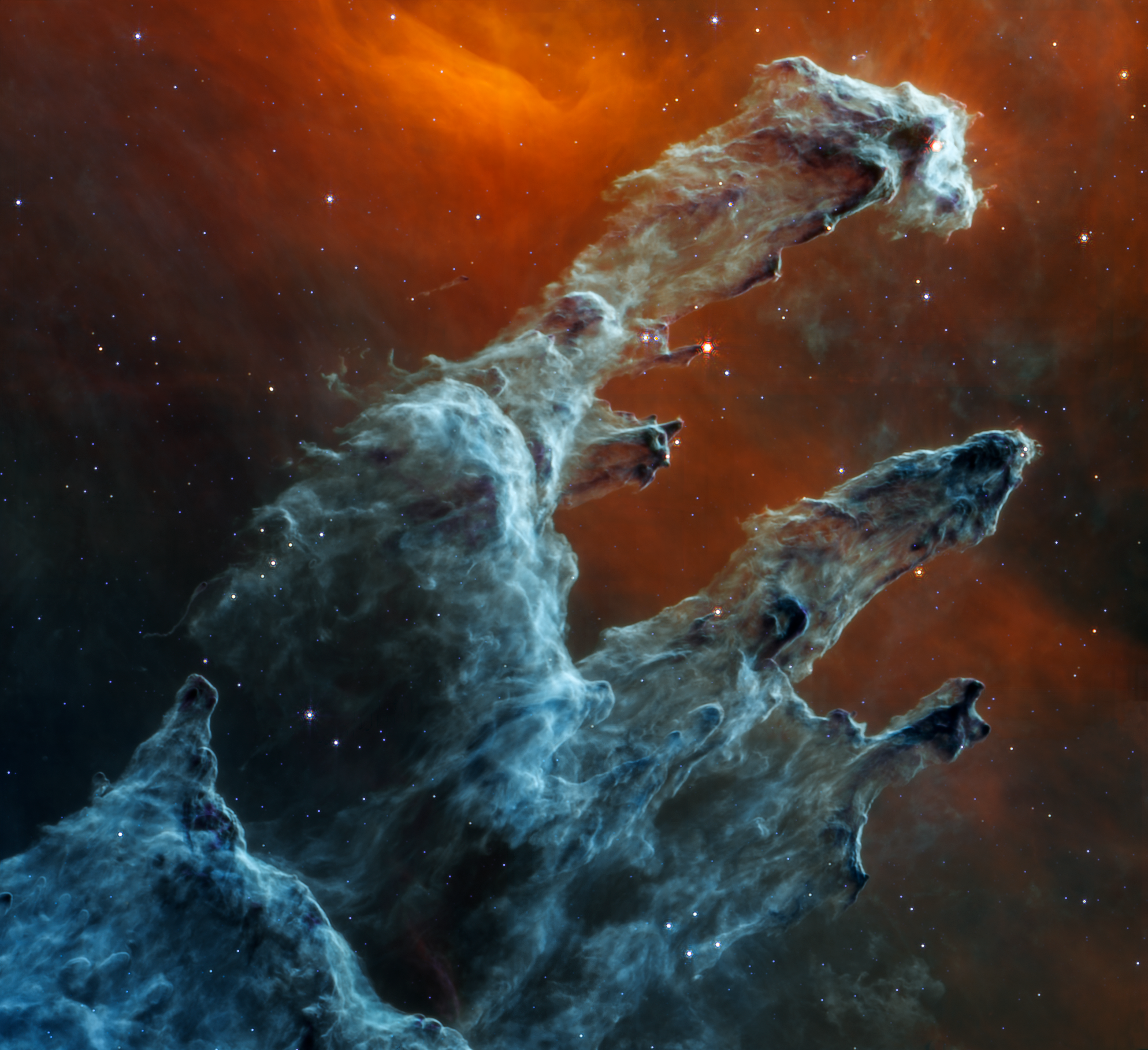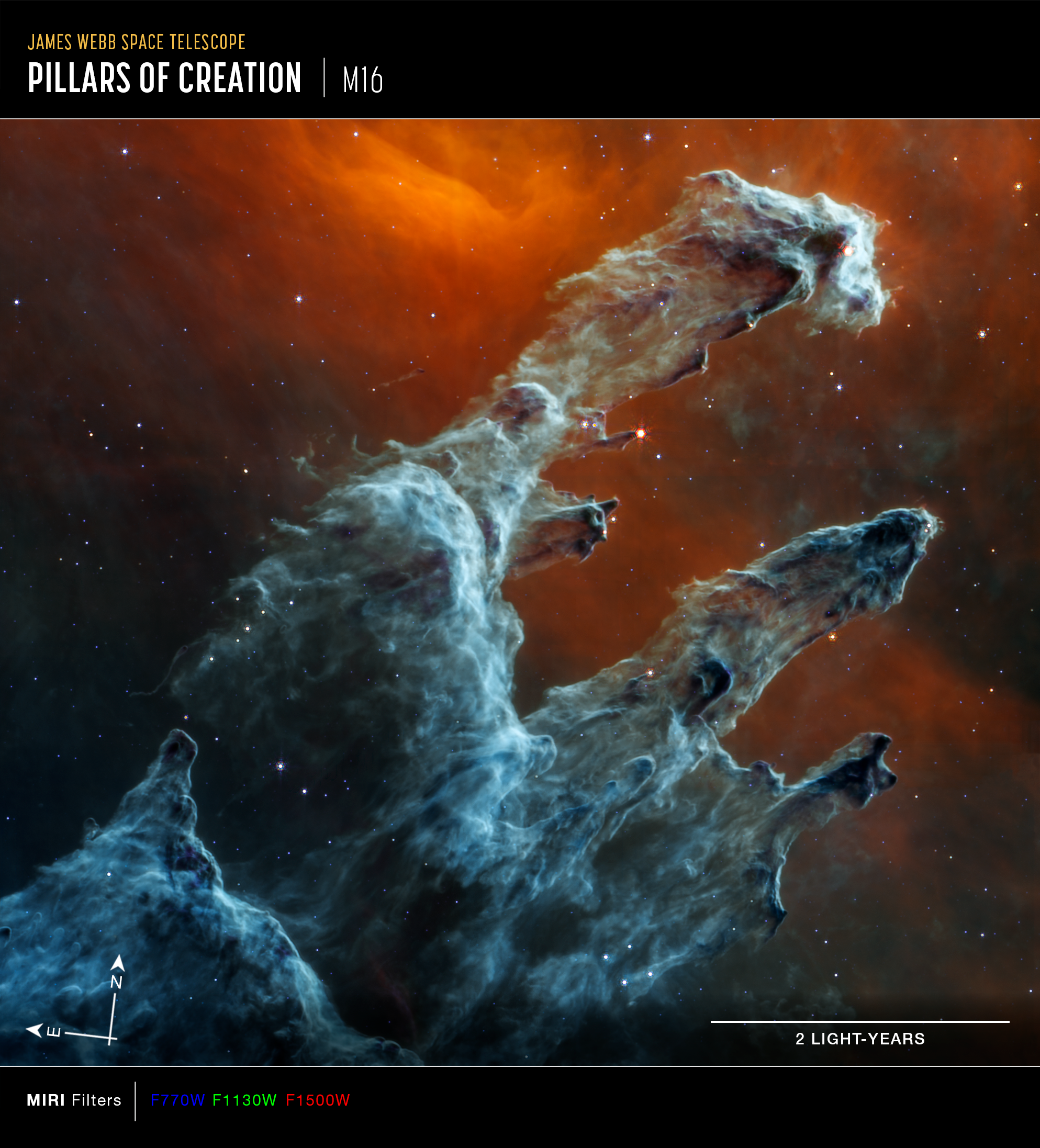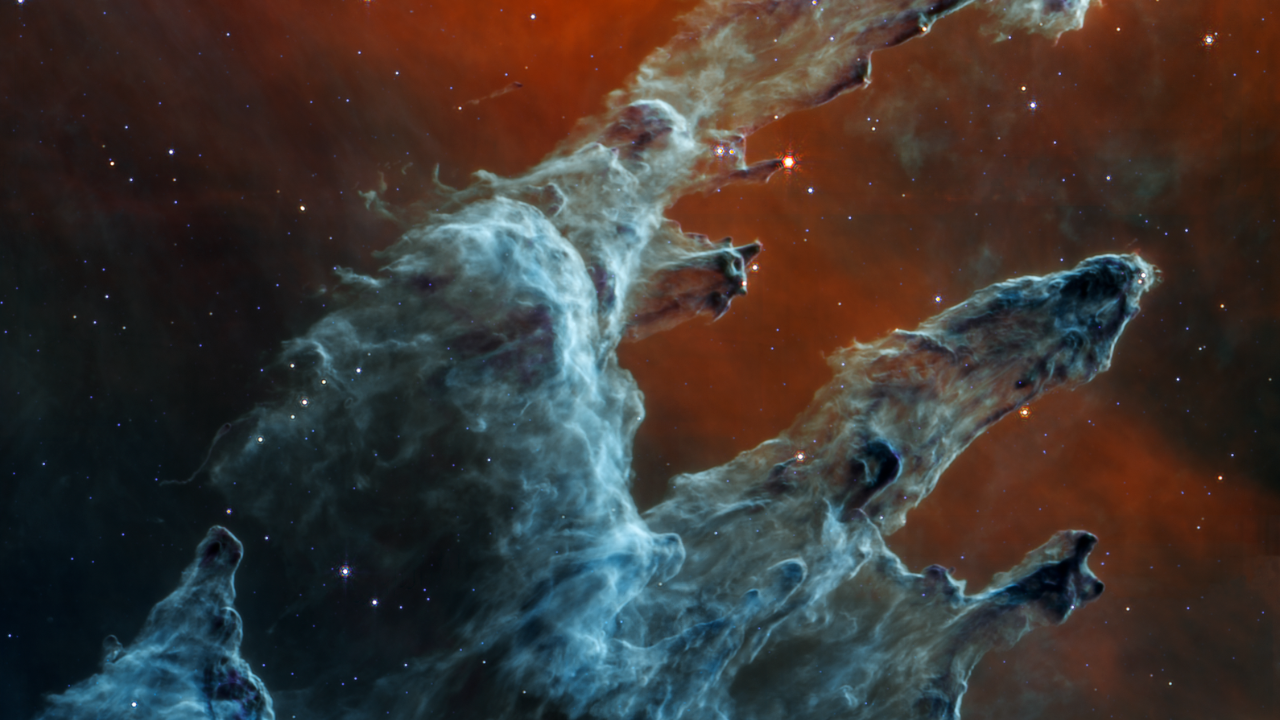1 min read
Pillars of Creation (MIRI Image)

NASA’s James Webb Space Telescope’s mid-infrared view of the Pillars of Creation strikes a chilling tone. Thousands of stars that exist in this region disappear – and seemingly endless layers of gas and dust become the centerpiece.
The detection of dust by Webb’s Mid-Infrared Instrument (MIRI) is extremely important – dust is a major ingredient for star formation. Many stars are actively forming in these dense blue-gray pillars. When knots of gas and dust with sufficient mass form in these regions, they begin to collapse under their own gravitational attraction, slowly heat up – and eventually form new stars.
Although the stars appear missing, they aren’t. Stars typically do not emit much mid-infrared light. Instead, they are easiest to detect in ultraviolet, visible, and near-infrared light. In this MIRI view, two types of stars can be identified. The stars at the end of the thick, dusty pillars have recently eroded the material surrounding them. They show up in red because their atmospheres are still enshrouded in cloaks of dust. In contrast, blue tones indicate stars that are older and have shed most of their gas and dust.
Mid-infrared light also details dense regions of gas and dust. The red region toward the top, which forms a delicate V shape, is where the dust is both diffuse and cooler. And although it may seem like the scene clears toward the bottom left of this view, the darkest gray areas are where densest and coolest regions of dust lie. Notice that there are many fewer stars and no background galaxies popping into view.
Webb’s mid-infrared data will help researchers determine exactly how much dust is in this region – and what it’s made of. These details will make models of the Pillars of Creation far more precise. Over time, we will begin to more clearly understand how stars form and burst out of these dusty clouds over millions of years.
Contrast this view with Webb’s near-infrared light image.
MIRI was contributed by ESA and NASA, with the instrument designed and built by a consortium of nationally funded European Institutes (the MIRI European Consortium) in partnership with JPL and the University of Arizona.
Extended Description and Image Alt Text
Extended Description
At the bottom left are the thickest regions of gas and dust, which appear light blue and dark gray-blue. There are many layers of semi-opaque gas and dust overlaying one another. The first pillar points to the top right of the image. There is one prominent red star, with tiny spikes at its tip. Lower on this pillar, which forms a diagonal from bottom left to top right, there are several darker areas of dust that jut out, many with bright red stars, which appear as small red dots. Below the top pillar are two slightly smaller pillars, both ending in dark gray-blue regions. The second pillar has a dark arch that looks like an upside-down L halfway down. The third pillar is set off in dark blue and gray shades. At the bottom left is another overlapping area of gas and dust that forms a peak, but is also colored in various shades of gray and light blue. The background of this scene is washed in shades of deep red and light red. Toward the top center, a V shape appears above the top-most pillar. At its lowest point, it is brilliant red. There are only several dozen tiny bright white and blue stars. Larger stars appear redder and are embedded in the pillars.
Image Alt Text
Semi-opaque layers of blue and gray gas and dust start at the bottom left and rise toward the top right. There are three prominent pillars. The left pillar is the largest and widest. The peaks of the second and third pillars are set off in darker shades of blue outlines. Few red stars appear within the pillars. Some blue and white stars dot the overall scene.
About the Object
- R.A. PositionR.A. PositionRight ascension – analogous to longitude – is one component of an object's position.18:18:48.17
- Dec. PositionDec. PositionDeclination – analogous to latitude – is one component of an object's position.-13:48:26.03
- ConstellationConstellationOne of 88 recognized regions of the celestial sphere in which the object appears.Serpens
- DistanceDistanceThe physical distance from Earth to the astronomical object. Distances within our solar system are usually measured in Astronomical Units (AU). Distances between stars are usually measured in light-years. Interstellar distances can also be measured in parsecs.6,500 light-years (2,000 parsecs)
- DimensionsDimensionsThe physical size of the object or the apparent angle it subtends on the sky.Image is approximately 7 light-years across
About the Data
- Data DescriptionData DescriptionProposal: A description of the observations, their scientific justification, and the links to the data available in the science archive.
Science Team: The astronomers who planned the observations and analyzed the data. "PI" refers to the Principal Investigator.This image was created from JWST data from proposal: 2739 (K. Pontoppidan)
- InstrumentInstrumentThe science instrument used to produce the data.JWST>MIRI
- Exposure DatesExposure DatesThe date(s) that the telescope made its observations and the total exposure time.14 Aug 2022
- FiltersFiltersThe camera filters that were used in the science observations.F770W, F1130W, F1500W
- Object NameObject NameA name or catalog number that astronomers use to identify an astronomical object.M16, Eagle Nebula, NGC 6611
- Object DescriptionObject DescriptionThe type of astronomical object.Emission Nebula
- Release DateOctober 28, 2022
- Science ReleaseHaunting Portrait: NASA’s Webb Reveals Dust, Structure in Pillars of Creation
- CreditNASA, ESA, CSA, STScI; Image Processing: Joseph DePasquale (STScI), Alyssa Pagan (STScI)

These images are a composite of separate exposures acquired by the James Webb Space Telescope using the MIRI instrument. Several filters were used to sample different infrared wavelength ranges. The color results from assigning different hues (colors) to each monochromatic (grayscale) image associated with an individual filter. In this case, the assigned colors are: Blue: F770W, Green: F1130W, Red: F1500W

Related Images & Videos

Pillars of Creation (MIRI Compass Image)
This image of the Pillars of Creation, captured by Webb’s Mid-Infrared Instrument (MIRI), shows compass arrows, scale bar, and color key for reference. It lies within the Eagle Nebula, which is also known as Messier 16 (M16). The north and east compass arrows show the...

The Pillars of Creation in Mid-Infrared Light
Compare NASA’s James Webb Space Telescope mid-infrared light image of the Pillars of Creation to its near-infrared light image in this short video tour. Thousands of stars have formed in this region, but interstellar dust cloaks the scene in mid-infrared light, which is why the...
Share
Details
Laura Betz
NASA’s Goddard Space Flight Center
Greenbelt, Maryland
laura.e.betz@nasa.gov
NASA, ESA, CSA, STScI
Joseph DePasquale (STScI), Alyssa Pagan (STScI)































